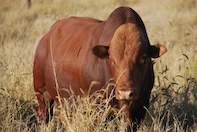
Alex Holm, the director of the Potchefstroom College of Agriculture at the time, is seen as a champion of the breed. In 1912, he formed a studbook to facilitate planned breeding and guide breeding decisions.
This had a major impact on the development of the modern Afrikaner cattle breed, as very few of the old-time breeders believed in the registering of cattle.
The first Afrikaner cattle were registered in 1907. These were two bulls and four females, belonging to WH and JR Buhrman from Ermelo, and four bulls and 47 females, belonging to the then Transvaal Department of Agriculture.
During the next five years, only 29 bulls and 113 females were registered, but in 1913, 263 animals were registered. Registration temporarily declined thereafter, when there was a shortage of official inspectors, but figures soared to about 860 animals registered every year after 1916.
Jozef du Plessis of the farm Rietfontein near Kroonstad, is seen as another pioneer. He implemented specific breeding strategies to improve his herd, starting with a small, select breeding herd shortly after the second Anglo-Boer War.
He became renowned for his top class bulls, such as Weeskind, Makman, Kanon and Klein Jozef. Weeskind, for one, was sold for 1 500 pounds, which was a huge sum of money to pay for a bull in those times.
 Afrikaner cattle originated from wild cattle on the Asian steppes. Afrikaner cattle are produced throughout South Africa, as well as in some...
Afrikaner cattle originated from wild cattle on the Asian steppes. Afrikaner cattle are produced throughout South Africa, as well as in some...